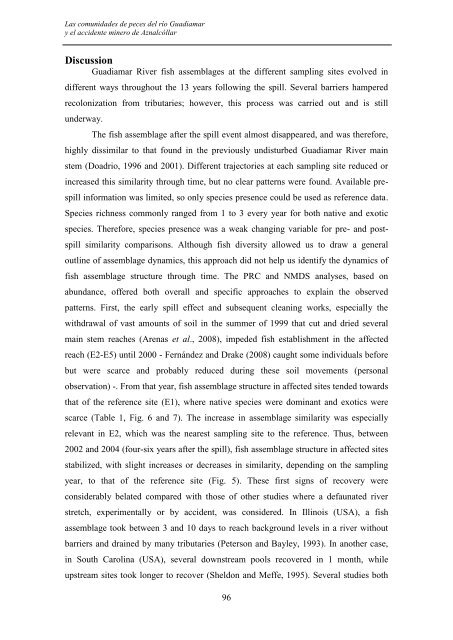las comunidades de peces del río guadiamar y el accidente minero ...
las comunidades de peces del río guadiamar y el accidente minero ...
las comunidades de peces del río guadiamar y el accidente minero ...
You also want an ePaper? Increase the reach of your titles
YUMPU automatically turns print PDFs into web optimized ePapers that Google loves.
Las <strong>comunida<strong>de</strong>s</strong> <strong>de</strong> <strong>peces</strong> <strong>de</strong>l <strong>río</strong> Guadiamar<br />
y <strong>el</strong> acci<strong>de</strong>nte <strong>minero</strong> <strong>de</strong> Aznalcóllar<br />
Discussion<br />
Guadiamar River fish assemblages at the different sampling sites evolved in<br />
different ways throughout the 13 years following the spill. Several barriers hampered<br />
recolonization from tributaries; however, this process was carried out and is still<br />
un<strong>de</strong>rway.<br />
The fish assemblage after the spill event almost disappeared, and was therefore,<br />
highly dissimilar to that found in the previously undisturbed Guadiamar River main<br />
stem (Doadrio, 1996 and 2001). Different trajectories at each sampling site reduced or<br />
increased this similarity through time, but no clear patterns were found. Available prespill<br />
information was limited, so only species presence could be used as reference data.<br />
Species richness commonly ranged from 1 to 3 every year for both native and exotic<br />
species. Therefore, species presence was a weak changing variable for pre- and postspill<br />
similarity comparisons. Although fish diversity allowed us to draw a general<br />
outline of assemblage dynamics, this approach did not h<strong>el</strong>p us i<strong>de</strong>ntify the dynamics of<br />
fish assemblage structure through time. The PRC and NMDS analyses, based on<br />
abundance, offered both overall and specific approaches to explain the observed<br />
patterns. First, the early spill effect and subsequent cleaning works, especially the<br />
withdrawal of vast amounts of soil in the summer of 1999 that cut and dried several<br />
main stem reaches (Arenas et al., 2008), impe<strong>de</strong>d fish establishment in the affected<br />
reach (E2-E5) until 2000 - Fernán<strong>de</strong>z and Drake (2008) caught some individuals before<br />
but were scarce and probably reduced during these soil movements (personal<br />
observation) -. From that year, fish assemblage structure in affected sites ten<strong>de</strong>d towards<br />
that of the reference site (E1), where native species were dominant and exotics were<br />
scarce (Table 1, Fig. 6 and 7). The increase in assemblage similarity was especially<br />
r<strong>el</strong>evant in E2, which was the nearest sampling site to the reference. Thus, between<br />
2002 and 2004 (four-six years after the spill), fish assemblage structure in affected sites<br />
stabilized, with slight increases or <strong>de</strong>creases in similarity, <strong>de</strong>pending on the sampling<br />
year, to that of the reference site (Fig. 5). These first signs of recovery were<br />
consi<strong>de</strong>rably b<strong>el</strong>ated compared with those of other studies where a <strong>de</strong>faunated river<br />
stretch, experimentally or by acci<strong>de</strong>nt, was consi<strong>de</strong>red. In Illinois (USA), a fish<br />
assemblage took between 3 and 10 days to reach background lev<strong>el</strong>s in a river without<br />
barriers and drained by many tributaries (Peterson and Bayley, 1993). In another case,<br />
in South Carolina (USA), several downstream pools recovered in 1 month, while<br />
upstream sites took longer to recover (Sh<strong>el</strong>don and Meffe, 1995). Several studies both<br />
96

















